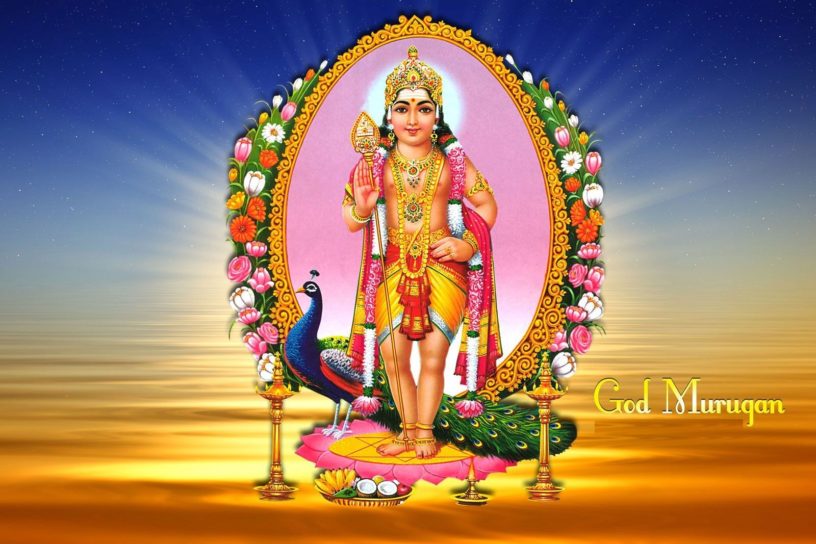The month of Kaartik (October 14 – November 12, 2019) provides us with numerous opportunities to worship the Divine, such as Divali and Goverdhan puja. It is said to be one of the most auspicious months in the Hindu calendar. The worship of Tulsi Maataa is especially prescribed at this time and many a devotee makes offerings to Divinity at the base of the tulsi plant. Tulsi Vivaah, the moment where Satyanaaraayan Swami and Tulsi Maa were united, also occurs during this blessed month.
The month culminates in Kaartik Snaan (or Kaartik Nahaan), the worship of Shri Vishnu through the performance of Satyanaaraayan puja at the beach. From the historical point of view, the importance of the final day lies in the defeat of the mighty demon, Tarakasura by Swami Kartekai. It is said that after having successfully led the battle against the forces of unrighteousness, He cleansed His body in the ocean. He also made a pronouncement that anyone who takes a ritual bath in the ocean on this day, will be especially blessed. Thus, the bath that one takes for Kaartik is an act of beesarjan; we offer ourselves to the Lord, seeking to be purified of all our accumulated sins or negative karmas.
Kartekai represents that infinite reality or spiritual essence in all individuals. Thus, the immersion in the waterways is more than a ritual. It serves as a reminder of the constant need to immerse our lives in spirituality instead of materialism, to make a conscientious effort to transform our lives, to merge in and realise our deeper nature of pure consciousness. It symbolises our victory over negative qualities and materialism. It infuses the purifying flow of spiritual abundance and enlightened vision with its attendant positive qualities of serenity, faith, endurance, tranquillity of mind, control of the senses and renunciation of selfish actions and desires. In a state of purified devotion, one realises the divinity within us.
Kaartik Snaan reminds us of the need for developing true spirituality, while at the same time highlighting the multifaceted nature of the Lord. It also displays a fundamental fact of Sanaatan Dharma, that there are numerous pathways to the Divine, and while they all lead to the Lord, incorporating the different modes of worship can prove even more beneficial.
As with all forms of Divinity, Swaami Kartekai’s form is replete with symbolism. Kartekai has many names: He is called Murugan, Skanda and Subramanyam. He is also called Shadaanana, Sanmokh, Kumar, Sena-Pati and Guha. At the mythological level, he is the younger son of Lord Shiva and Mother Parvati and was born of the six sparks that emerged from Lord Shiva’s forehead. His vehicle is a peacock named Paravani, which symbolises the control of the lower tendencies in humans; to achieve spiritual excellence, one has to subdue ahamkaar (ego) and abhimaan (false pride). His weapon is the spear, representative of the power to remove the vaasanas or negative tendencies of devotees. His consort’s name is Deivayanai.
Kartekai is considered the God of War, responsible for destroying the demon Tarak. His function is to lead the charge against evil forces in this world, hence His name, Sena-Pati. Kartekai’s brother is Shri Ganesh, who removes the obstacles in our lives and is also the principle of discernment and wisdom in every individual. Kartekai is the principle that destroys all evil forces within us and blesses us with knowledge.
Kartekai is associated with the number six. His six faces represent the qualities of God: felicity, fullness, immortal youth, endless energy, protection from evil and spiritual splendour. God’s forms always engender spiritual splendour in the hearts of all devotees. These divine qualities are considered a yardstick by which one can measure the Avataar level of claimants of incarnations. Kartekai demonstrated all these qualities.
The six heads of Kartekai also represent the six chakras (subtle spiritual energy centres) within the body. The journey from the Muladhaara chakra (at the base of the spine) to the Sahasraara chakra (crown chakra of enlightenment located above the head) is only possible with the destruction of internal evil forces and the right spiritual knowledge. The six chakras are the six battlefields of Skanda. This is why He is also called Subramanyam, the omniscient Spirit of the universe.
Kartekai is also associated with Agin Devta, the one who burns away all impurities and is responsible for moving up the spiritual ladder of the chakras. He is considered to be the sum total of the many powers of Brahma. As we celebrate the purpose of Kartekai’s appearance, we are in reality worshipping all the forms of Divinity that can manifest within our lives.



